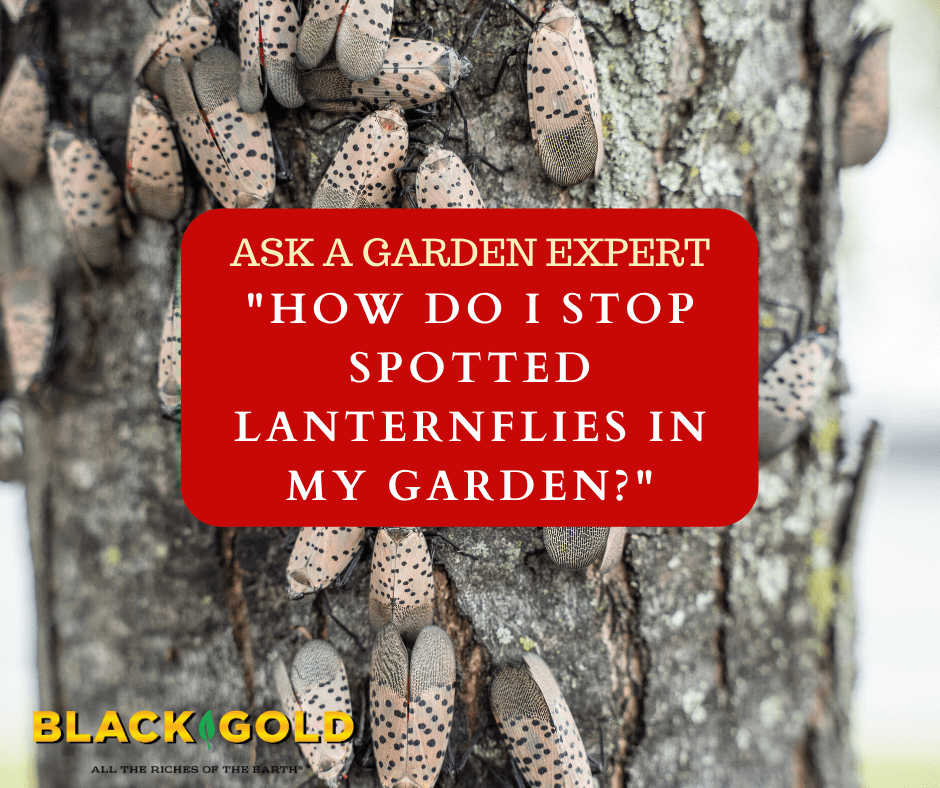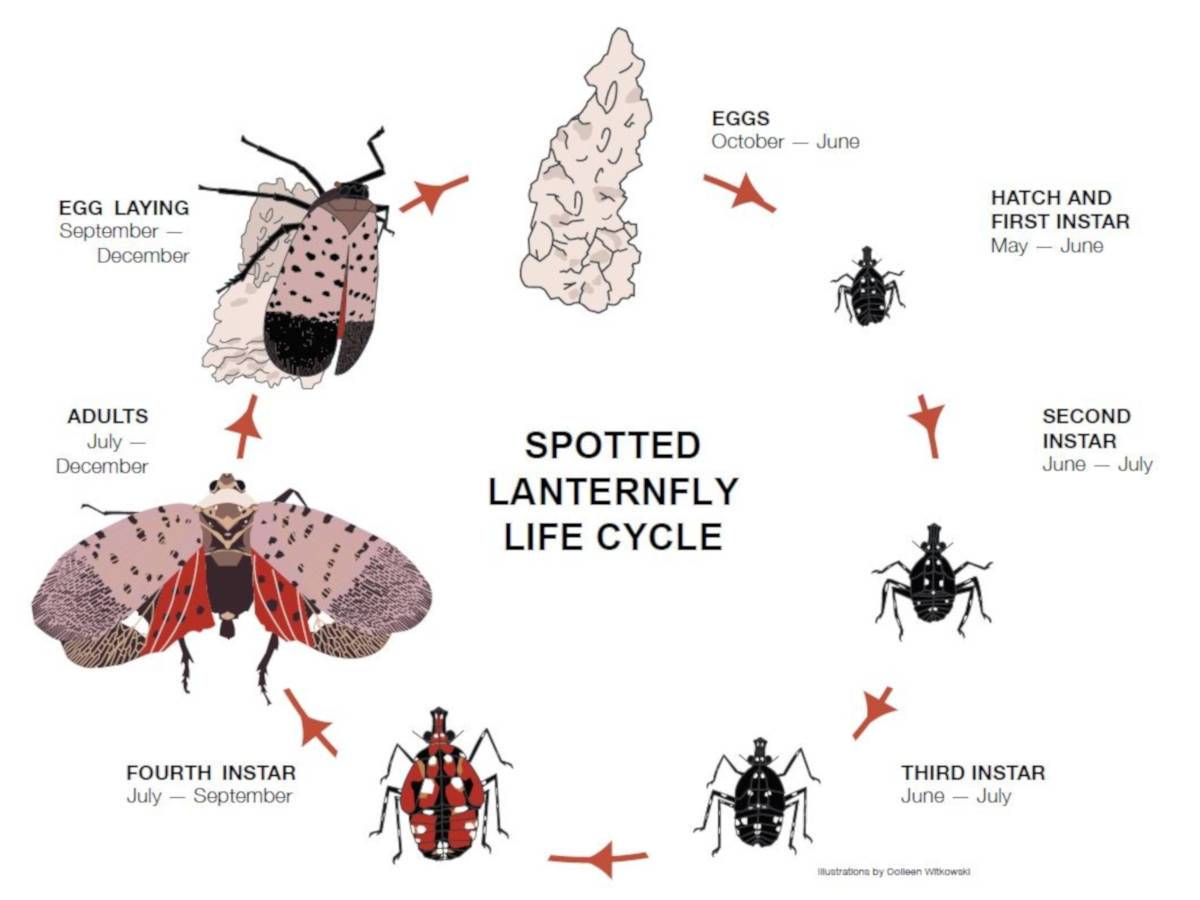
“How Do I Stop the Spotted Lanternfly in My Garden?” Question from Tulip Tramp of Wilmington, Delaware
Answer: Oh, you asked the right question. Spotted lanternflies (Lycorma delicatula) first appeared in my garden this year, so I am getting firsthand experience trying to manage them, and they are a nightmare. They are prolific, large, and cluster and suck the juices out of trees in very high numbers–enough to kill. They are lightning-fast, hard-to-kill, and nasty. In my yard, they attack black walnut (Juglans nigra) and willow trees (Salix spp.). They’ve also been hanging out on my dahlias and cardoon. For whatever reason, these fruit-tree pests have yet to attack my peach trees, apple trees, and fig–likely because they favor black walnuts. But, I am also on a quest to lower their numbers and keep them away from my garden.
Spotted Lanternfly Origins

Spotted lanternflies are highly destructive insects that originate from China, India, and East Asia. Their preferred host is tree-of-heaven (Ailanthus altissima), a Chinese tree that was first brought to the United States in 17 84 and quickly became a common weed tree across much of North America. Tree-of-heaven contains chemicals that make spotted lanternflies bad-tasting and inedible–giving them natural protection from predators that would eat them.
Aggressive spotted lanternflies are newcomers to our shores. They were first discovered in the United States in eastern Pennsylvania in the fall of 2014. Since then, they have taken over areas across Delaware, Maryland, Pennsylvania, New Jersey, and Virginia, where they have caused huge economic damage to the forest, orchard-fruit, and grape industries as well as home landscapes and gardens and the businesses that serve them.
Thankfully, these insects can be somewhat cold-sensitive. “The researchers found that bark temperature of about 14 degrees Fahrenheit is the limit at which the beetle can survive (Frank Kummer, The Philadelphia Inquirer, 2018).” That means they will be limited to regions with milder winters, maybe as cold as USDA Hardiness Zone 5.
Spotted Lanternfly Life Cycle and Management

When you know an insect pest’s life cycle, it provides more knowledge to work with when sorting out ways to kill it. A spotted lanternfly female lays many eggs on branches (or practically anything else when populations are high). One female can lay one or two rows of 30 – 60 eggs. The egg masses are camouflaged with a layer of a protective substance that looks like mud. If you can find the eggs, scrape them off and smash them on sight (see the video below).
The first-hatch, or first-instar, nymphs emerge in May or June, and at this time, they are most vulnerable to pesticides. The nymphs begin to suck at the stems of trees, secreting honeydew as they go. The honeydew then encourages the growth of black mold, another negative side effect of these pests. As the lanternflies grow, they shed their skins and develop new features–including wings. Adults are much harder to kill.
Spotted Lanternfly Management Methods
I favor organic gardening, so I try to work with OMRI Listed pesticides, but spotted lanternflies can be hard to destroy. From what I have read, effective insecticides that are approved for organic gardening include Stoller’s Golden Pest Spray Oil and insecticides containing pyrethroids, among others. These have also been shown to kill nymphs quickly up to the third instar. More powerful insecticides are needed to efficiently kill adults, so it is best to try to kill lanternflies early on.
Initially, I tried to use insecticidal soap on first and second instar nymphs in my yard, but it was not powerful enough to kill them all. Now, I am moving to Safer pyrethrin spray, which is stronger. It should work better. I have also invested in a sprayer that will allow me to target higher tree branches where I see the pests in masses. Pyrethrin spray can also kill beneficial insects and pollinators, so I am just going to target the spotted lanternflies that are on my black walnuts and willows and keep the spray away from any garden flowers. If you can reach them, early instar lanternflies are also easy to kill by just dropping them in soapy water. They cannot swim and die quickly. Hopefully, a combination of these steps will make an impact.
Penn State is also working on a potential bio-insecticide (derived from a native fungus) for lanternflies (click here to learn more). Let’s hope this research will offer an easier, natural way to kill the beasts.
For more information about research and possible management ideas, contact your local extension agent and let them know that you have found lanternflies on your property. Visit U.S. Department of Agriculture (USDA) extension website to find your local agent.
Happy spotted lanternfly hunting. Maybe if we all work to manage them in our yards, we can reduce their populations for the good of all.
Jessie Keith
Black Gold Horticulturist
I also could not resist adding this very clever trap method devised by a very smart teen in my area!
